 Whatha’s looking it? As raw milk’s popularity grows, so does scrutiny. It’s been a tough twelve months for proponents of raw milk. Last April, as many as 81 Colorado consumers were sickened by campylobacter associated with raw milk. Last September, about 35 people became ill with campylobacter, apparently from milk from a Wisconsin dairy. And just in the last few weeks, 17 raw milk drinkers in the Midwest associated with a dairy in Indiana have become ill with campylobacter. Added to all that, Whole Foods last month notified producers in four states—California, Washington, Connecticut, and Pennsylvania—that it would no longer stock raw milk.
Whatha’s looking it? As raw milk’s popularity grows, so does scrutiny. It’s been a tough twelve months for proponents of raw milk. Last April, as many as 81 Colorado consumers were sickened by campylobacter associated with raw milk. Last September, about 35 people became ill with campylobacter, apparently from milk from a Wisconsin dairy. And just in the last few weeks, 17 raw milk drinkers in the Midwest associated with a dairy in Indiana have become ill with campylobacter. Added to all that, Whole Foods last month notified producers in four states—California, Washington, Connecticut, and Pennsylvania—that it would no longer stock raw milk.
What’s the problem? As far as the public health and medical establishments are concerned, whenever people consume raw dairy products, it’s a problem. In their view, raw milk is inherently dangerous and shouldn’t be produced or consumed.
But the fact that as many as three million Americans regularly consume raw milk, according to the Weston A. Price Foundation, calls the health establishment’s radical view into question. Still and all, raw dairy proponents are coming around to the view there is a problem—it’s just not the problem the authorities would have us believe.
In their view, these are really problems of success, stemming from raw milk’s fast-growing popularity.
As part of a long-standing campaign to encourage consumption of locally produced nutrient-dense foods, the Weston A. Price Foundation has been encouraging consumers to switch to unpasteurized milk.
But that doesn’t mean the organization wants conventional dairies to just discontinue pasteurization and sell their milk raw. As the organization says on its Real Milk web site, it “recommends Real Milk–that is, milk that is full-fat, unprocessed, and from pasture-fed cows. We do NOT recommend consumption of raw milk from conventional confinement dairies or dairies which produce milk intended for pasteurization…Real Milk, that is, raw whole milk from grass-fed cows (fed pasture, hay and silage), produced under clean conditions and promptly refrigerated, contains many anti-microbial and immune-supporting components; but this protective system in raw milk can be overwhelmed, and the milk contaminated, in situations conducive to filth and disease. Know your farmer!”
With growing numbers of consumers willing to pay $7 and more a gallon for raw milk, more dairies are looking to say good-bye to their local processors, who pay on the order of $1 to $1.50 a gallon for milk intended for pasteurization. While there are no exact figures, in states where raw dairies are licensed, like Pennsylvania, New York, and Massachusetts, the number of raw dairies has been growing. Even in states where raw milk can only be sold via private arrangements, known as cowshares or herdshares, like Michigan and Ohio, the number of dairies getting into raw milk is understood to be rising sharply.
The biggest problem may be that at least some farmers are slipping up in their production of safe raw milk. That doesn’t mean raw milk can’t be produced safely on a consistent basis. Obviously, many dozens of dairies are doing it day in and day out, year after year. But as Tim Wightman of the Farm-to-Consumer Foundation points out, “There is value in understanding what happened” at the dairies that have had outbreaks over the last year.
Wightman suggests that dairies experiencing outbreaks may in some cases have unwisely responded to increases in consumer demand by introducing animals purchased from a factory system known for problems. “Looking for the best deal has its hidden costs…for the farmer and the consumer, and the very web we depend on,” he says.
It’s precisely because of its success that the raw milk community is now being placed under a microscope by the media and regulators. There have been lengthy features challenging raw milk’s safety in both The New York Times and The Wall Street Journal in just the last few weeks.
Part of the challenge for raw milk proponents is that at least some have not wanted to admit to the reality that people can become sick from drinking raw milk (just as they can, and do, from pasteurized milk and other foods). It’s been thought that cows that graze on pasture or eat hay produce milk that isn’t susceptible to pathogens. It’s also been assumed that public health authorities are biased in their investigations of outbreaks. As a result, the Weston A. Price Foundation has expressed skepticism about whether raw milk has really been the culprit in the Colorado and Wisconsin outbreaks, among others.
A Wall Street Journal blog posting following up on the paper’s article accuses proponents of “dismissing warnings about bacterial contaminants…” Unfortunately, the knee-jerk defensiveness in the face of probable outbreaks, which wasn’t noticed when raw milk was a fringe food, just won’t cut it any more now that raw milk is regularly making the media big leagues.
In a truly open market, the marketplace would force the bad dairies out of business. But we don’t have a truly open market—we have one where regulators are in a position to force good dairies out of business for the transgressions of bad dairies.
Therefore, it’s up to the raw milk community to police itself. It could be there needs to be a raw dairy association, with real authority to penalize dairies that don’t meet high standards. If the raw dairy community won’t take the responsibility to watch over its interests, the government will likely take over this responsibility even more than it already does, and the results won’t be geared toward protecting our rights to access the foods of our choice.



